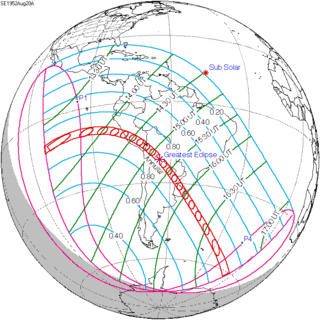| Solar eclipse of August 20, 1952 | |
|---|---|
| Type of eclipse | |
| Nature | Annular |
| Gamma | −0.6102 |
| Magnitude | 0.942 |
| Maximum eclipse | |
| Duration | 400 s (6 min 40 s) |
| Coordinates | 21°42′S 64°06′W / 21.7°S 64.1°W |
| Max. width of band | 264 km (164 mi) |
| Times (UTC) | |
| Greatest eclipse | 15:13:35 |
| References | |
| Saros | 144 (13 of 70) |
| Catalog # (SE5000) | 9403 |
An annular solar eclipse occurred at the Moon's descending node of orbit on Wednesday, August 20, 1952,[1] with a magnitude of 0.942. A solar eclipse occurs when the Moon passes between Earth and the Sun, thereby totally or partly obscuring the image of the Sun for a viewer on Earth. An annular solar eclipse occurs when the Moon's apparent diameter is smaller than the Sun's, blocking most of the Sun's light and causing the Sun to look like an annulus (ring). An annular eclipse appears as a partial eclipse over a region of the Earth thousands of kilometres wide. Occurring 1.2 days after apogee (on August 19, 1952, at 12:00 UTC), the Moon's apparent diameter was smaller.[2]
Annularity was visible from Peru including the capital city Lima, northeastern Chile, Bolivia including the constitutional capital Sucre and seat of government La Paz, Argentina, Paraguay, southern Brazil and Uruguay. A partial eclipse was visible for most of Central America, the Caribbean, and South America.
- ^ "August 20, 1952 Annular Solar Eclipse". timeanddate. Retrieved 5 August 2024.
- ^ "Moon Distances for London, United Kingdom, England". timeanddate. Retrieved 5 August 2024.
